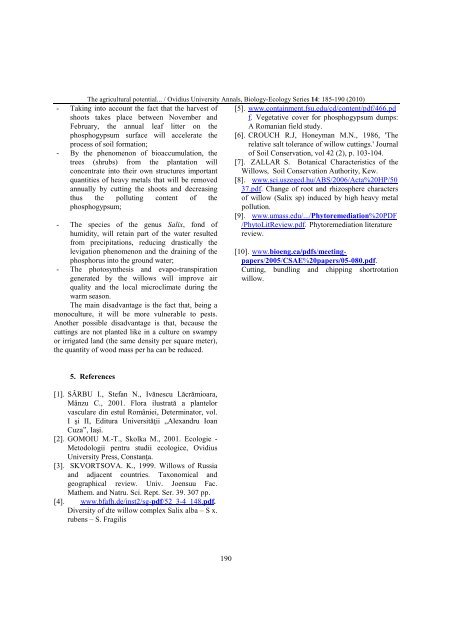VOLUM OMAGIAL - Facultatea de Ştiinţe ale Naturii şi Ştiinţe Agricole
VOLUM OMAGIAL - Facultatea de Ştiinţe ale Naturii şi Ştiinţe Agricole
VOLUM OMAGIAL - Facultatea de Ştiinţe ale Naturii şi Ştiinţe Agricole
You also want an ePaper? Increase the reach of your titles
YUMPU automatically turns print PDFs into web optimized ePapers that Google loves.
The agricultural potential... / Ovidius University Annals, Biology-Ecology Series 14: 185-190 (2010)<br />
- Taking into account the fact that the harvest of<br />
shoots takes place between November and<br />
February, the annual leaf litter on the<br />
phosphogypsum surface will accelerate the<br />
process of soil formation;<br />
- By the phenomenon of bioaccumulation, the<br />
trees (shrubs) from the plantation will<br />
concentrate into their own structures important<br />
quantities of heavy metals that will be removed<br />
annually by cutting the shoots and <strong>de</strong>creasing<br />
thus the polluting content of the<br />
phosphogypsum;<br />
- The species of the genus Salix, fond of<br />
humidity, will retain part of the water resulted<br />
from precipitations, reducing drastically the<br />
levigation phenomenon and the draining of the<br />
phosphorus into the ground water;<br />
- The photosynthesis and evapo-transpiration<br />
generated by the willows will improve air<br />
quality and the local microclimate during the<br />
warm season.<br />
The main disadvantage is the fact that, being a<br />
monoculture, it will be more vulnerable to pests.<br />
Another possible disadvantage is that, because the<br />
cuttings are not planted like in a culture on swampy<br />
or irrigated land (the same <strong>de</strong>nsity per square meter),<br />
the quantity of wood mass per ha can be reduced.<br />
5. References<br />
[1]. SÂRBU I., Stefan N., Ivănescu Lăcrămioara,<br />
Mânzu C., 2001. Flora ilustrată a plantelor<br />
vasculare din estul României, Determinator, vol.<br />
I <strong>şi</strong> II, Editura Universităţii „Alexandru Ioan<br />
Cuza”, Ia<strong>şi</strong>.<br />
[2]. GOMOIU M.-T., Skolka M., 2001. Ecologie -<br />
Metodologii pentru studii ecologice, Ovidius<br />
University Press, Constanţa.<br />
[3]. SKVORTSOVA. K., 1999. Willows of Russia<br />
and adjacent countries. Taxonomical and<br />
geographical review. Univ. Joensuu Fac.<br />
Mathem. and Natru. Sci. Rept. Ser. 39. 307 pp.<br />
[4]. www.bfafh.<strong>de</strong>/inst2/sg-pdf/52_3-4_148.pdf.<br />
Diversity of dte willow complex Salix alba – S x.<br />
rubens – S. Fragilis<br />
190<br />
[5]. www.containment.fsu.edu/cd/content/pdf/466.pd<br />
f. Vegetative cover for phosphogypsum dumps:<br />
A Romanian field study.<br />
[6]. CROUCH R.J, Honeyman M.N., 1986, 'The<br />
relative salt tolerance of willow cuttings.' Journal<br />
of Soil Conservation, vol 42 (2), p. 103-104.<br />
[7]. ZALLAR S. Botanical Characteristics of the<br />
Willows, Soil Conservation Authority, Kew.<br />
[8]. www.sci.uszeged.hu/ABS/2006/Acta%20HP/50<br />
37.pdf. Change of root and rhizosphere characters<br />
of willow (Salix sp) induced by high heavy metal<br />
pollution.<br />
[9]. www.umass.edu/.../Phytoremediation%20PDF<br />
/PhytoLitReview.pdf. Phytoremediation literature<br />
review.<br />
[10]. www.bioeng.ca/pdfs/meetingpapers/2005/CSAE%20papers/05-080.pdf.<br />
Cutting, bundling and chipping shortrotation<br />
willow.





